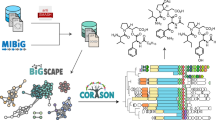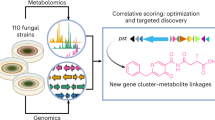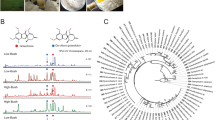Abstract
Pseudomonads are cosmopolitan microorganisms able to produce a wide array of specialized metabolites. These molecules allow Pseudomonas to scavenge nutrients, sense population density and enhance or inhibit growth of competing microorganisms. However, these valuable metabolites are typically characterized one-molecule–one-microbe at a time, instead of being inventoried in large numbers. To index and map the diversity of molecules detected from these organisms, 260 strains of ecologically diverse origins were subjected to mass-spectrometry-based molecular networking. Molecular networking not only enables dereplication of molecules, but also sheds light on their structural relationships. Moreover, it accelerates the discovery of new molecules. Here, by indexing the Pseudomonas specialized metabolome, we report the molecular-networking-based discovery of four molecules and their evolutionary relationships: a poaeamide analogue and a molecular subfamily of cyclic lipopeptides, bananamides 1, 2 and 3. Analysis of their biosynthetic gene cluster shows that it constitutes a distinct evolutionary branch of the Pseudomonas cyclic lipopeptides. Through analysis of an additional 370 extracts of wheat-associated Pseudomonas, we demonstrate how the detailed knowledge from our reference index can be efficiently propagated to annotate complex metabolomic data from other studies, akin to the way in which newly generated genomic information can be compared to data from public databases.
This is a preview of subscription content, access via your institution
Access options
Subscribe to this journal
Receive 12 digital issues and online access to articles
$119.00 per year
only $9.92 per issue
Buy this article
- Purchase on Springer Link
- Instant access to full article PDF
Prices may be subject to local taxes which are calculated during checkout





Similar content being viewed by others
References
Gross, H. & Loper, J. E. Genomics of secondary metabolite production by Pseudomonas spp. Nat. Prod. Rep. 26, 1408–1446 (2009).
Kloepper, J. W., Leong, J., Teintze, M. & Schroth, M. N. Pseudomonas siderophores: a mechanism explaining disease-suppressive soils. Curr. Microbiol. 4, 317–320 (1980).
Ron, E. Z. & Rosenberg, E. Natural roles of biosurfactants. Environ. Microbiol. 3, 229–236 (2001).
Raaijmakers, J. M., de Bruijn, I. & de Kock, M. J. D. Cyclic lipopeptide production by plant-associated Pseudomonas spp.: diversity, activity, biosynthesis, and regulation. Mol. Plant. Microbe Interact. 19, 699–710 (2006).
Raaijmakers, J. M., De Bruijn, I., Nybroe, O. & Ongena, M. Natural functions of lipopeptides from Bacillus and Pseudomonas: more than surfactants and antibiotics. FEMS Microbiol. Rev. 34, 1037–1062 (2010).
Davies, J. Specialized microbial metabolites: functions and origins. J. Antibiot. 66, 361–364 (2013).
Ichinose, Y., Taguchi, F. & Mukaihara, T. Pathogenicity and virulence factors of Pseudomonas syringae. J. Gen. Plant Pathol. 79, 285–296 (2013).
Raaijmakers, J. M., Vlami, M. & de Souza, J. T. Antibiotic production by bacterial biocontrol agents. Antonie Van Leeuwenhoek 81, 537–547 (2002).
Mascuch, S. J. et al. Direct detection of fungal siderophores on bats with white-nose syndrome via fluorescence microscopy-guided ambient ionization mass spectrometry. PLoS ONE 10, e0119668 (2015).
Hoyt, J. R. et al. Bacteria isolated from bats inhibit the growth of Pseudogymnoascus destructans, the causative agent of white-nose syndrome. PLoS ONE 10, e0121329 (2015).
Yang, J. Y. et al. Molecular networking as a dereplication strategy. J. Nat. Prod. 76, 1686–1699 (2013).
Laatsch, H. AntiBase 2014: The Natural Compound Identifier (Wiley, 2014).
Buckingham, J. Dictionary of Natural Products Supplement 4 (Taylor & Francis, 1997).
Blunt, J. W. & Munro, M. MarinLit. A Database of the Literature on Marine Natural Products (Royal Society of Chemistry, 2003); http://pubs.rsc.org/marinlit/
Watrous, J. et al. Mass spectral molecular networking of living microbial colonies. Proc. Natl Acad. Sci. USA 109, E1743–E1752 (2012).
Nguyen, D. D. et al. MS/MS networking guided analysis of molecule and gene cluster families. Proc. Natl Acad. Sci. USA 110, E2611–E2620 (2013).
Wang, M. et al. Sharing and community curation of mass spectrometry data with Global Natural Products Social Molecular Networking. Nat. Biotechnol. 34, 828–837 (2016).
Smoot, M. E., Ono, K., Ruscheinski, J., Wang, P.-L. & Ideker, T. Cytoscape 2.8: new features for data integration and network visualization. Bioinformatics 27, 431–432 (2011).
Dong, Y., Manfredini, F. & Dimopoulos, G. Implication of the mosquito midgut microbiota in the defense against malaria parasites. PLoS Pathog. 5, e1000423 (2009).
Jošić, D. et al. Antifungal activities of indigenous plant growth promoting Pseudomonas spp. from alfalfa and clover rhizosphere. Front. Life Sci. 8, 131–138 (2015).
Pauwelyn, E. et al. New linear lipopeptides produced by Pseudomonas cichorii SF1-54 are involved in virulence, swarming motility, and biofilm formation. Mol. Plant Microbe Interact. 26, 585–598 (2013).
Zachow, C. et al. The novel lipopeptide poaeamide of the endophyte Pseudomonas poae RE*1-1-14 is involved in pathogen suppression and root colonization. Mol. Plant Microbe Interact. 28, 800–810 (2015).
Kersten, R. D. et al. Glycogenomics as a mass spectrometry-guided genome-mining method for microbial glycosylated molecules. Proc. Natl Acad. Sci. USA 110, E4407–E4416 (2013).
Sumner, L. W. et al. Proposed minimum reporting standards for chemical analysis chemical analysis working group (CAWG) metabolomics standards initiative (MSI). Metabolomics 3, 211–221 (2007).
Pettit, G. R. et al. Isolation of labradorins 1 and 2 from Pseudomonas syringae pv. coronafaciens. J. Nat. Prod. 65, 1793–1797 (2002).
Kong, F., Singh, M. P. & Carter, G. T. Pseudopyronines A and B, alpha-pyrones produced by a marine Pseudomonas sp. F92S91, and evidence for the conversion of 4-hydroxy-α-pyrone to 3-furanone. J. Nat. Prod. 68, 920–923 (2005).
Chu, M. et al. Structure of sch 419560, a novel α-pyrone antibiotic produced by Pseudomonas fluorescens. J. Antibiot. 55, 215–218 (2002).
Moree, W. J. et al. Interkingdom metabolic transformations captured by microbial imaging mass spectrometry. Proc. Natl Acad. Sci. USA 109, 13811–13816 (2012).
Abdel-Mawgoud, A. M., Lépine, F. & Déziel, E. Rhamnolipids: diversity of structures, microbial origins and roles. Appl. Microbiol. Biotechnol. 86, 1323–1336 (2010).
Gonçalves-de-Albuquerque, C. F. et al. Possible mechanisms of Pseudomonas aeruginosa-associated lung disease. Int. J. Med. Microbiol. 306, 20–28 (2016).
Grundmann, F. et al. Identification and isolation of insecticidal oxazoles from Pseudomonas spp. Beilstein J. Org. Chem. 8, 749–752 (2012).
Bauer, J. S. et al. Biosynthetic origin of the antibiotic pseudopyronines A and B in Pseudomonas putida BW11M1. ChemBioChem 16, 2491–2497 (2015).
Kersten, R. D. et al. A mass spectrometry-guided genome mining approach for natural product peptidogenomics. Nat. Chem. Biol. 7, 794–802 (2011).
Gross, H. et al. The genomisotopic approach: a systematic method to isolate products of orphan biosynthetic gene clusters. Chem. Biol. 14, 53–63 (2007).
Kuiper, I. et al. Characterization of two Pseudomonas putida lipopeptide biosurfactants, putisolvin I and II, which inhibit biofilm formation and break down existing biofilms. Mol. Microbiol. 51, 97–113 (2004).
Li, W. et al. The antimicrobial compound xantholysin defines a new group of Pseudomonas cyclic lipopeptides. PLoS ONE 8, e62946 (2013).
Rainey, P. B., Brodey, C. L. & Johnstone, K. Biological properties and spectrum of activity of tolaasin, a lipodepsipeptide toxin produced by the mushroom pathogen Pseudomonas tolaasii. Physiol. Mol. Plant Pathol. 39, 57–70 (1991).
Tran, H., Kruijt, M. & Raaijmakers, J. M. Diversity and activity of biosurfactant-producing Pseudomonas in the rhizosphere of black pepper in Vietnam. J. Appl. Microbiol. 104, 839–851 (2008).
Kruijt, M., Tran, H. & Raaijmakers, J. M. Functional, genetic and chemical characterization of biosurfactants produced by plant growth-promoting Pseudomonas putida 267. J. Appl. Microbiol. 107, 546–556 (2009).
Rokni-Zadeh, H. et al. Genetic and functional characterization of cyclic lipopeptide white-line-inducing principle (WLIP) production by rice rhizosphere isolate Pseudomonas putida RW10S2. Appl. Environ. Microbiol. 78, 4826–4834 (2012).
Vlassak, K., Van Holm, L., Duchateau, L., Vanderleyden, J. & De Mot, R. Isolation and characterization of fluorescent Pseudomonas associated with the roots of rice and banana grown in Sri Lanka. Plant Soil 145, 51–63 (1992).
Emanuele, M. C. et al. Corpeptins, new bioactive lipodepsipeptides from cultures of Pseudomonas corrugata. FEBS Lett. 433, 317–320 (1998).
Pauwelyn, E. Epidemiology and Pathogenicity Mechanisms of Pseudomonas cichorii, the Causal Agent of Midrib Rot in Greenhouse-Grown Butterhead Lettuce (Lactuca sativa L.) (Ghent University, 2012).
Morikawa, M. et al. A new lipopeptide biosurfactant produced by Arthrobacter sp. strain MIS38. J. Bacteriol. 175, 6459–6466 (1993).
D'aes, J. et al. To settle or to move? The interplay between two classes of cyclic lipopeptides in the biocontrol strain Pseudomonas CMR12a. Environ. Microbiol. 16, 2282–2300 (2014).
Huang, C.-J. et al. Characterization of cichopeptins, new phytotoxic cyclic lipodepsipeptides produced by Pseudomonas cichorii SF1-54 and their role in bacterial midrib rot disease of lettuce. Mol. Plant. Microbe. Interact. 28, 1009–1022 (2015).
Lange, A., Sun, H., Pilger, J., Reinscheid, U. M. & Gross, H. Predicting the structure of cyclic lipopeptides by bioinformatics: structure revision of arthrofactin. ChemBioChem 13, 2671–2675 (2012).
Medema, M. H. et al. Pep2Path: automated mass spectrometry-guided genome mining of peptidic natural products. PLoS Comput. Biol. 10, e1003822 (2014).
Weber, T. et al. antiSMASH 3.0—a comprehensive resource for the genome mining of biosynthetic gene clusters. Nucleic Acids Res. 43, W237–W243 (2015).
Medema, M. H. et al. Minimum information about a biosynthetic gene cluster. Nat. Chem. Biol. 11, 625–631 (2015).
Vizcaino, M. I. & Crawford, J. M. The colibactin warhead crosslinks DNA. Nat. Chem. 7, 411–417 (2015).
Medema, M. H., Cimermancic, P., Sali, A., Takano, E. & Fischbach, M. A. A systematic computational analysis of biosynthetic gene cluster evolution: lessons for engineering biosynthesis. PLoS Comput. Biol. 10, e1004016 (2014).
Bankevich, A. et al. SPAdes: a new genome assembly algorithm and its applications to single-cell sequencing. J. Comput. Biol. 19, 455–477 (2012).
Kumar, S., Stecher, G. & Tamura, K. MEGA7: molecular evolutionary genetics analysis version 7.0 for bigger datasets. Mol. Biol. Evol. 33, 1870–1874 (2016).
Medema, M. H., Takano, E. & Breitling, R. Detecting sequence homology at the gene cluster level with MultiGeneBlast. Mol. Biol. Evol. 30, 1218–1223 (2013).
Acknowledgements
Financial support was provided by the National Institutes of Health (NIH) grant GM097509 (to B.S.M. and P.C.D.). M.H.M. was supported by Rubicon (825.13.001) and Veni (863.15.002) grants from the Netherlands Organization for Scientific Research (NWO). J.R. and V.J.C. were supported by a grant from the Netherlands BEBasic Foundation (project F07.003.01) R.D.M. was supported by KU Leuven grant GOA/011/2008. M.G.K.G. is the recipient of a post-doctoral fellowship from FWO Vlaanderen (12M4615N). A.M.K. and T.L.C. were supported by NSF grants DEB-1115895 and DEB-1336290 and US FWS grant F12AP01081. L.M.S. was supported by a National Institutes of Health IRACDA K12 GM068524 grant award. J.G.M. was supported by BBSRC Institute Strategic Program (ISPG) grant BB/J004553/1 and University of East Anglia start-up funding. T.H.M. was supported by the BBSRC Institute Strategic Program (ISPG) ‘Optimization of nutrients in soil-plant systems’ (BBS/E/C/00005196). The authors acknowledge Bruker and NIH grants GMS10RR029121 and P41-GM103484 for support in the form of shared instrumentation and the computational infrastructure. NMR data were acquired at the University of California, San Diego Skaggs School of Pharmacy and Pharmaceutical Sciences NMR Facility. The authors thank V.V. Phelan for a review of this manuscript and M. Wang, A.T. Nelson and L.-F. Nothias-Scaglia for contributions.
Author information
Authors and Affiliations
Contributions
D.D.N., A.V.M., X.L., M.H.M. and P.C.D. designed the research. D.D.N., A.V.M., N.K., X.L., M.S., J.F., K.A., T.L.L., B.M.D., B.S.M., M.H.M. and P.C.D. performed research. D.D.N., A.V.M., N.K., X.L., M.S., M.G.K.G., J.F., B.M.D., R.D.M., M.H.M. and P.C.D. analysed data. M.G.K.G., V.J.C., T.L.C., J.G.M., T.H.M., L.M.S., A.M.K., J.M.R. and R.D.M. contributed microbial strains or extracts. D.D.N., A.V.M. and P.C.D. wrote the paper.
Corresponding authors
Ethics declarations
Competing interests
The authors declare no competing financial interests.
Supplementary information
Supplementary information
Legends for Supplementary Tables 1–8, Supplementary Figures 1–16 (PDF 4360 kb)
Supplementary Table 1
Known Pseudomonas specialized metabolites versus strain collection. A list of the 260 Pseudomonas isolates and the additional 370 wheat-associated samples from the UK, their collection information (if available), and the known compounds they contribute to. (XLSX 144 kb)
Supplementary Table 2
Known Pseudomonas specialized metabolites molecular families versus strain collection. A list of the 260 Pseudomonas isolates and the additional 370 wheat- associated samples from the UK, their collection information (if available), and the molecular families they contribute to. (XLSX 156 kb)
Supplementary Table 3
A summary table of known Pseudomonas specialized metabolites observed and the number of strains that contribute to them. (XLSX 17 kb)
Supplementary Table 4
A summary table of known Pseudomonas specialized metabolite molecular families that were observed and the number of strains that contribute to them. (XLSX 23 kb)
Supplementary Table 5
Supplementary Table 5. Poaeamide B (m/z 1,253) NMR table. MS/MS provided the amino acid sequence tag. Amino acid, 3-hydroxy acyl chain chemical shifts and measured coupling constants obtained from 2D 1H-13C heteronuclear single quantum coherence (HSQC), 2D 1H-13C heteronuclear multiple bond correlation (HMBC), 2D 1H-13C double quantum filtered correlation spectroscopy (COSY), and 1H-NMR spectra were used to confirm the identity of the amino acid residues and 3-hydroxy acyl chain specification. (XLSX 14 kb)
Supplementary Table 6
Bananamide 1, 2, and 3 NMR table. MS/MS provided the amino acid sequence tag. Amino acid, 3-hydroxy acyl chain chemical shifts and measured coupling constants obtained from 2D 1H-13C heteronuclear single quantum coherence (HSQC), 2D 1H-13C heteronuclear multiple bond correlation (HMBC), 2D 1H-13C double quantum filtered correlation spectroscopy (DQF-COSY), and 1H-NMR spectra were used to confirm the identity of the amino acid residues and 3-hydroxy acyl chains specification. (XLSX 15 kb)
Supplementary Table 7
Poaeamide B gene cluster table. Genes in the poaeamide B biosynthetic gene cluster from P. synxantha CR32 based on homology and protein domain analysis. (XLSX 11 kb)
Supplementary Table 8
Bananamide gene cluster table. Genes in the bananamide biosynthetic gene cluster from P. fluorescens BW11P2 based on homology and protein domain analysis. (XLSX 10 kb)
Rights and permissions
About this article
Cite this article
Nguyen, D., Melnik, A., Koyama, N. et al. Indexing the Pseudomonas specialized metabolome enabled the discovery of poaeamide B and the bananamides. Nat Microbiol 2, 16197 (2017). https://doi.org/10.1038/nmicrobiol.2016.197
Received:
Accepted:
Published:
DOI: https://doi.org/10.1038/nmicrobiol.2016.197
This article is cited by
-
Fast mass spectrometry search and clustering of untargeted metabolomics data
Nature Biotechnology (2024)
-
Annotation of natural product compound families using molecular networking topology and structural similarity fingerprinting
Nature Communications (2023)
-
Genome mining and chemical characterization of a new cyclic lipopeptide associated with MDN-0066 from Pseudomonas moraviensis HN2 cultured in a valine-rich medium
The Journal of Antibiotics (2023)
-
Kimidinomycin, a new antibiotic against Mycobacterium avium complex, produced by Streptomyces sp. KKTA-0263
The Journal of Antibiotics (2022)
-
High-confidence structural annotation of metabolites absent from spectral libraries
Nature Biotechnology (2022)



